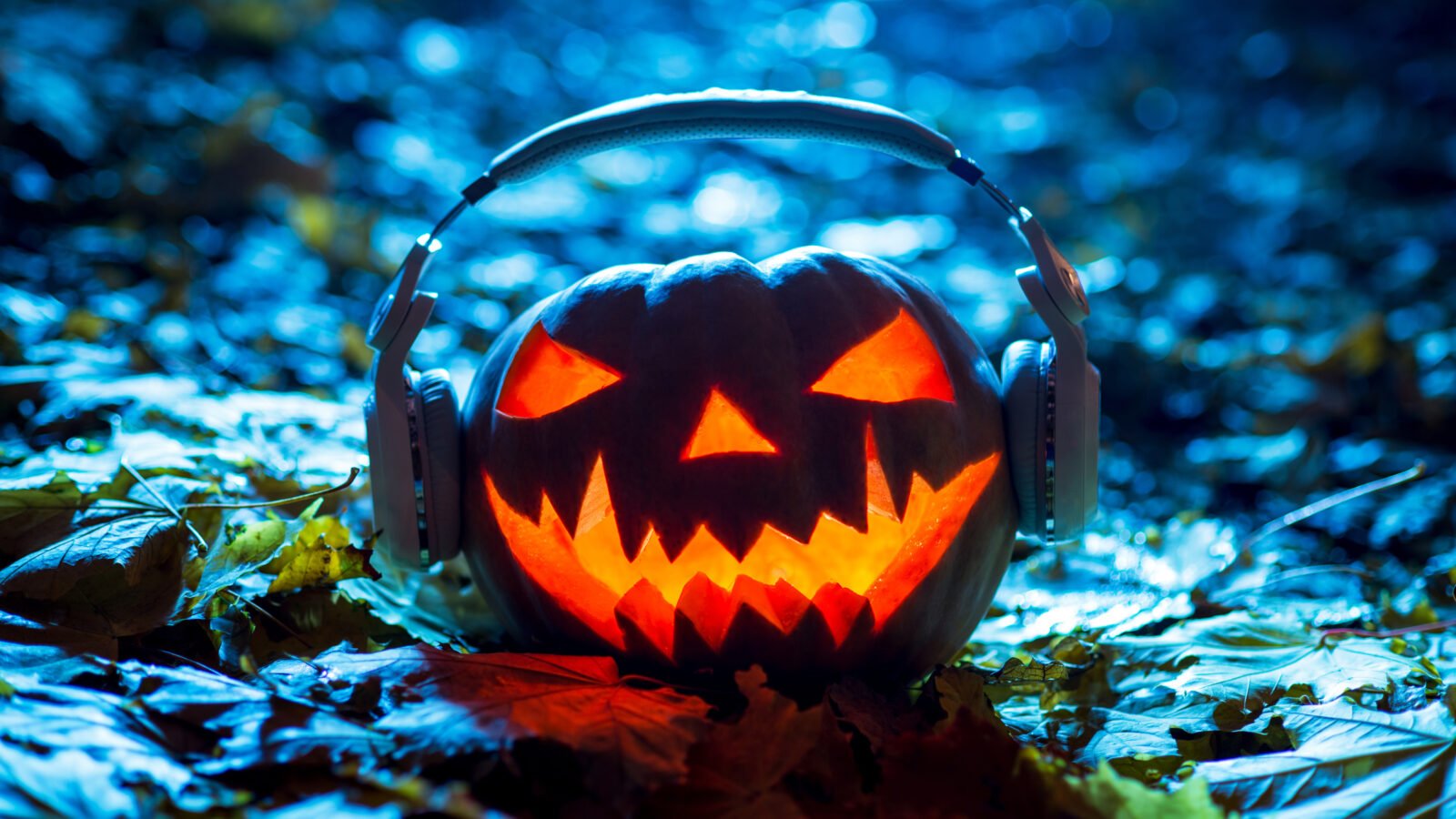 Whether you're looking for spooky music as you wait for trick-or-treaters, or you need some music to accompany your own "danse macabre," we have your perfect Halloween soundtrack.
Whether you're looking for spooky music as you wait for trick-or-treaters, or you need some music to accompany your own "danse macabre," we have your perfect Halloween soundtrack.
Camille Saint-Saëns: Danse macabre
This fiendish dance by Saint-Saëns is practically made for Halloween. It depicts Death waking the dead from their graves with his trusty fiddle at the stroke of midnight (signaled by 12 strokes from the harp). The violin has its E-string detuned by a half-step, changing the interval between the two highest strings from a pleasant-sounding fifth to a dissonant tritone, an interval long considered the “devil in music.”
Thomas Adès: Totentanz
Not to be confused with Franz Liszt's piece of the same name, Thomas Adès' bleak, darkly comic Totentanz is, like Saint-Saëns' Danse macabre, a musical depiction of the Dance of Death. The composer reaped (pun intended) inspiration from a 15th-century fresco in Lübeck, in which Death leads everyone from the Pope to a newborn baby towards their eternal fates.
Johann Sebastian Bach: Toccata and Fugue in D minor
Though it's now considered one of the most famous pieces for organ, JS Bach's Toccata and Fugue in D minor wasn’t always as instantly recognizable as it is now. The piece was little known until Felix Mendelssohn — who rescued many works by Bach from obscurity — rediscovered it and played it in concert in 1840. Used in films like Dr. Jekyll and Mr. Hyde and The Phantom of the Opera, the piece is practically synonymous with horror.
Modest Mussorgsky: "Catacombs" from Pictures at an Exhibition
Mussorgsky composed this multi-movement work in memory of his friend, artist Viktor Hartmann. Each movement corresponds to a picture in Hartmann's gallery, with one pairing with Hartmann's Paris catacombs. The painting depicts Hartmann and two other men walking through the labyrinthine catacombs, illuminated only by lamplight.
Modest Mussorgsky: Night on Bald Mountain
Mussorgsky made yet another evocative — and frightening — contribution to the repertoire with his tone poem depicting a witches' sabbath. However, his original orchestration was deemed too crude and heavy-handed to be fit for public performance. It was Rimsky-Korsakov's 1886 arrangement that finally brought fame to Mussorgsky's piece, albeit after the composer’s death.
Edvard Grieg: "In the Hall of the Mountain King" from Peer Gynt
This movement from Grieg's incidental music to Henrik Ibsen’s play is yet another quintessentially creepy piece of classical music. The accompanying scene comes in the play's second act, when Peer Gynt approaches the throne of the monstrous, troll-like Mountain King. Ironically, Grieg wrote in a letter to his friend that he found the music he’d composed to this scene so trivial that he "literally could not bear to hear" it!
Robert Schumann: "Frightening" from Kinderszenen (Scenes from Childhood)
In his Scenes from Childhood, Robert Schumann captures some of the emotions associated with his childhood in a collection of thirteen piano pieces.
Pyotr Ilyich Tchaikovsky: "The Witch" from Children's Album
Composed as an homage to Schumann's Kinderszenen, Tchaikovsky intended for the 24 easy pieces in his Children's Album to be played by children, not for them. The twentieth piece is usually called "The Witch" in English, but specifically refers to Baba Yaga, a monstrous old hag from Slavic folklore.
John Williams: "Devil's Dance" from The Witches of Eastwick
Loosely based on John Updike's novel of the same name, The Witches of Eastwick is about three middle-aged bachelorettes whose lives are disrupted by the appearance of a demonic stranger, as well as the realization that they are witches. An arrangement John Williams' piece for solo violin and piano is popular among violinists.
Bernard Herrmann: Suite from Psycho
Just about everyone is familiar with the screeching string glissandi associated with Psycho's shower scene. But few know that what would become one of the most famous movie soundtracks ever was almost never written. Herrmann almost didn't accept director Alfred Hitchcock's request to compose music for the film, since the film was too low-budget to pay well. After being convinced to go through with the project, Herrmann cut costs by scoring the entire film for string orchestra.
Hector Berlioz: "March to the Scaffold" & "Dreams of a Witches’ Sabbath" from Symphonie fantastique
Symphonie fantastique tells the story of a "sensitive artist" who poisons himself with opium in anguish over an unrequited love. The suicide attempt fails, but the "artist" (who is generally assumed to be Berlioz himself) ends up plagued by some trippy hallucinations as a result. The last two movements of the symphony represent his terrible visions, from witnessing his own execution to the witches' Sabbath that causes mayhem at his funeral.
Dmitri Shostakovich: II. Allegro from Symphony No. 10
This symphony is about as intense and grotesque as they come. And it's no wonder why: premiering the year after Joseph Stalin's death, this symphony — the second movement in particular — is rumored to be portrait of the ruthless dictator himself. True or not, the Dmitri Shostakovich-written symphony no doubt expresses the terror the Soviet people felt under Stalin's iron grip.
Sergei Rachmaninoff: Isle of the Dead
After seeing the painting of the same name by Arnold Böcklin, Rachmaninoff was inspired to compose this tone poem. The beginning of the piece evokes oars breaking the surface of water, a nod to the crossing of the river Styx. Towards its middle, it quotes the "Dies irae" plainchant, like many other pieces on this list.
Franz Schubert: Die Erlkönig
Schubert's suspenseful Lied recounts a conversation between a son and his father on horseback. Despite his father’s attempts to console him, the boy's fear of being pursued by the mysterious "Erlkönig" (sometimes translated as "Elf-King") prove substantiated... and fatal.
Franz Liszt: Inferno from Dante Symphony
Liszt was on something of a Divine Comedy kick while composing this monumental, two-pronged symphony, conceiving it at the same time he wrote his Dante Sonata for piano. Inferno follows Dante and Virgil's descent through the nine circles of hell.
Gustav Mahler: Scherzo from Symphony No. 7
Smack-dab in the middle of what has been called Mahler's "Song of the Night," this third-movement Scherzo is a dark one. In fact, in the score, Mahler literally calls for this movement be played with a "shadowy" character.
György Ligeti: Atmosphères
Ligeti's enigmatic Atmosphères eschews rhythm and tonality in favor of a "clustered," almost fog-like sonority that’s both cool and creepy. Though many know the piece from Stanley Kubrick's 2001: A Space Odyssey, the piece was actually used in the film without Ligeti's permission. (The once-slighted composer eventually embraced the film's role in popularizing his music.)
Béla Bartók: Music for Strings, Percussion, and Celesta
This eerie piece by Béla Bartók has been included in everything from The Shining to episodes of Doctor Who. Among its unique qualities is division of the string section into two antiphonal parts and techniques like timpani glissandi, which were considered cutting-edge at the time of its premiere.
Sergei Rachmaninoff: Prelude in C-Sharp minor
This brooding prelude is one of Rachmaninoff's most famous compositions, as well as one of his first: he composed it as a 19-year-old graduate from Moscow Conservatory. It later served as the first of his 24 preludes — one for each major and minor key — in the tradition of Bach and Chopin.
Carl Orff: "O Fortuna" from Carmina Burana
One of the most popular excerpts in the classical repertoire, Orff opens and closes his epic cantata Carmina Burana with this hair-raising movement that laments the inevitability of fate. The Latin text of "O Fortuna" comes from the cantata’s source material, the medieval anthology Carmina Burana.
Giuseppe Verdi: "Dies irae" from Messa da Requiem
Verdi wrote his Requiem in memory of Italian writer Alessandro Manzoni, whose work he greatly admired. Unsurprisingly, there is an operatic sense of drama and structure in Verdi's monumental Requiem, not least of which in the fiery, recurring "Dies irae" theme.
John Williams: Shark Theme from Jaws
Changing the world only takes two notes. That's all John Williams needed to ingrain his score to the movie Jaws in the public consciousness. Now, its ascending minor-second motif has become practically synonymous with suspense.
Igor Stravinsky: The Rite of Spring
At its 1913 Paris premiere, Stravinsky's The Rite of Spring was eerie to first-time listeners from its very opening bars. (The opening bassoon solo was in such an uncommonly high register that audience members had trouble identifying which instrument it was.) As any music buff knows, the premiere performance only went downhill from there. If the music wasn't scandalous enough, the subject matter wasn't exactly pleasant, either; a young girl dances herself to death as part of a pagan ritual.
Paul Dukas: The Sorcerer's Apprentice
Dukas' piece about a klutzy young sorcerer who enchants a broom to do his chores for him mirrors the events of Goethe's original poem. The story — and Dukas' music — was famously immortalized in Disney’s Fantasia, with Mickey Mouse as the hapless apprentice.
Charles Gounod: Funeral March of a Marionette
Gounod's short piece has seen many incarnations since it was first composed in 1872. First, it was composed as a solo piano piece satirizing a famous English music critic. Later, Gounod changed its program and title, making the piece about a dead marionette and his funeral procession. Variations on Gounod's orchestrated version were later used to introduce the TV show Alfred Hitchcock Presents.
Lowell Liebermann: Gargoyles
Long fascinated by gargoyles, Liebermann looked to the scowling statues for inspiration while composing this piece. The result is at times grotesque and at times cheeky. But the always-enigmatic four-movement work for solo piano is a fitting tribute to his source material.
Bedřich Smetana: Macbeth and the Witches
"Double, double toil and trouble; fire burn, and cauldron bubble..." Here come Shakespeare's skin-crawlingly creepy witches! Smetana's thundering piece for solo piano evokes all the unease and terror associated with these ghastly creatures.
Frédéric Chopin: Marche funèbre
Chopin conceived of his funeral march independently of the rest of the B-flat minor sonata, composing the movement some two years before the remaining three movements. Since then, the funeral march has been famously used in state funerals. It was even played graveside at Chopin's own burial.
William Bolcom: Three Ghost Rags
For some more upbeat Halloween listening, try Bolcom's 1970 ragtime homage Three Ghost Rags. These three delightful little pieces — "Graceful Ghost," "Poltergeist," and "Dream Shadows" — are nods to a time long past and people long departed. Bolcom dedicated "Graceful Ghost" to his late father.
Maurice Ravel: Gaspard de la nuit
Ravel based his three-part suite for solo piano on poems included in Aloysius Bertrand's anthology of the same name. The poems upon which the pieces are certainly sinister. For example, the second movement ("Le Gibet") depicts a corpse left to hang in the desert. But for pianists, the scariest thing about Gaspard de la nuit may be its fiendish difficulty; the final "Scarbo" movement is considered by many to be one of the most challenging in the standard repertoire.
Giuseppe Tartini: Devil's Trill Sonata in G minor
Allegedly, Tartini conceived his virtuoso piece after the Devil himself appeared to him in a dream. After striking a deal together, the Devil proceeded to serenade Tartini on the violin, and upon waking up, the composer feverishly attempted to transcribe what he'd heard. Creepy... but, according to Tartini, the Devil wasn’t half bad.
Enjoy this full playlist... at your own peril!
Follow WFMT on Spotify and Apple Music!







